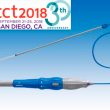This work showed that percutaneous septal ablation in patients with symptomatic hypertrophic cardiomyopathy is safe (and improves patient symptoms) and results in excellent long-term survival. Alcohol-induced infarction for treatment of symptomatic hypertrophic obstructive cardiomyopathy is controversial because, while it may relieve acute symptoms, it might also increase long-term mortality. This study sought to report<a href="https://solaci.org/en/2019/01/11/contemporary-results-for-septal-embolization-in-hypertrophic-cardiomyopathy/" title="Read more" >...</a>
CoreValve US Pivotal High Risk Trial: at 5 years, similar results
Courtesy of Dr. Carlos Fava. We are well aware of transcatheter aortic valve replacement’s (TAVR) effect in high-risk or inoperable patients at 5 years, even more after the PARTNER 1 trial. Yet, the outcomes of another relevant randomized study remained pending: el CoreValve US Pivotal High-Risk Trial. The CoreValve US Pivotal High-Risk Trial looked at the<a href="https://solaci.org/en/2018/11/21/corevalve-us-pivotal-high-risk-trial-at-5-years-similar-results/" title="Read more" >...</a>
TAVR in Low-Risk Patients with “Zero” Mortality and “Zero” Stroke
Transcatheter aortic valve replacement (TAVR) is now the standard of care for patients with symptomatic severe aortic stenosis who are at extreme, high, or intermediate risk for surgery. This multicenter, prospective study (Feasibility of Transcatheter Aortic Valve Replacement in Low-Risk Patients With Symptomatic, Severe Aortic Stenosis) included low-risk patients and was approved by the United<a href="https://solaci.org/en/2018/11/09/tavr-in-low-risk-patients-with-zero-mortality-and-zero-stroke/" title="Read more" >...</a>
Immediate Electrocardiography After TAVI, the Simplest Way to Predict Conduction Disorders
Taking into account a simple 12-lead electrocardiography performed immediately after transcatheter aortic valve implantation (TAVI), removing the temporary pacemaker immediately is safe in patients without right bundle branch block who are in sinus rhythm with PR interval <240 ms and QRS interval <150 ms. In cases of atrial fibrillation, a QRS interval <140 ms also reassures the decision<a href="https://solaci.org/en/2018/10/23/immediate-electrocardiography-after-tavi-the-simplest-way-to-predict-conduction-disorders/" title="Read more" >...</a>
Exercise Programs in Peripheral Artery Disease
Programmed exercises are recommended as initial management strategy for patients with peripheral artery disease (PAD). Most exercise programs include supervised treadmill walking twice or three times a week in a strategic facility (such as a gym). PAD patients often give up on these programs seeing as they might find it difficult to keep to a<a href="https://solaci.org/en/2018/10/22/exercise-programs-in-peripheral-artery-disease/" title="Read more" >...</a>
Safety of Lesion Deferral with iFR or FFR in Both Stable and Acute Patients
Overall, deferral of lesion revascularization is equally safe with both fractional flow reserve (FFR) and instantaneous wave-free ratio (iFR), with a low rate of events of about 4%. Lesions were more frequently deferred when iFR (as opposed to FFR) was used for functional assessment. Among patients with deferred lesions, acute patients experienced significantly more events<a href="https://solaci.org/en/2018/10/19/safety-of-lesion-deferral-with-ifr-or-ffr-in-both-stable-and-acute-patients/" title="Read more" >...</a>
Ambulatory Continuous Monitoring in Patients with Left Bundle Branch Block After TAVI
The incidence of arrhythmic events up to a year after implantation is high and involves almost half the patients with complete left bundle branch block following the procedure. Significant bradyarrhythmias occur in up to one-fifth of the patients, half of whom ultimately require a pacemaker. These data support the idea of a cardiac monitoring device<a href="https://solaci.org/en/2018/10/18/ambulatory-continuous-monitoring-in-patients-with-left-bundle-branch-block-after-tavi/" title="Read more" >...</a>
TCT 2018 | SOLVE-TAVI: Self-Expandable vs. Balloon-Expandable Valves and General vs. Local Anesthesia in One Study
This prospective, randomized, multicenter study included 447 patients with severe aortic stenosis and intermediate or high surgical risk randomized in a 2×2 factorial design to general vs. conscious sedation with local anesthesia and also to receiving the Sapien 3 valve (balloon-expandable) vs. CoreValve Evolut R (self-expandable). Primary end point was a composite of all-cause mortality,<a href="https://solaci.org/en/2018/10/08/tct-2018-solve-tavi-self-expandable-vs-balloon-expandable-valves-and-general-vs-local-anesthesia-in-one-study/" title="Read more" >...</a>
TCT 2018 | PORTICO-I: One Year Follow-Up for the Self-Expandable Reposisionable Valve
This study was simultaneously presented at TCT and published at JACCE, and it aims at showing the one-year outcomes of this new TAVR device, though follow-up is at 5 years. Primary end point was all cause mortality and secondary end points included clinical and echocardiographic events. With a total 941 patients (82,4 ± 5,9<a href="https://solaci.org/en/2018/10/05/tct-2018-portico-i-one-year-follow-up-for-the-self-expandable-reposisionable-valve/" title="Read more" >...</a>
TCT 2018 | NEOPRO: A Registry for Acurate neo and Evolut PRO
The purpose of this registry was to compare short-term clinical events and echocardiographic findings in two self-expanding valves used with transfemoral access, Acurate neo and Evolut PRO. The registry included a retrospective follow-up of 1551 patients, among whom 1263 received an Acurate neo valve and 288 received an Evolut Pro valve. The procedural success rates according to VARC-2 criteria were<a href="https://solaci.org/en/2018/10/04/tct-2018-neopro-a-registry-for-acurate-neo-and-evolut-pro/" title="Read more" >...</a>









